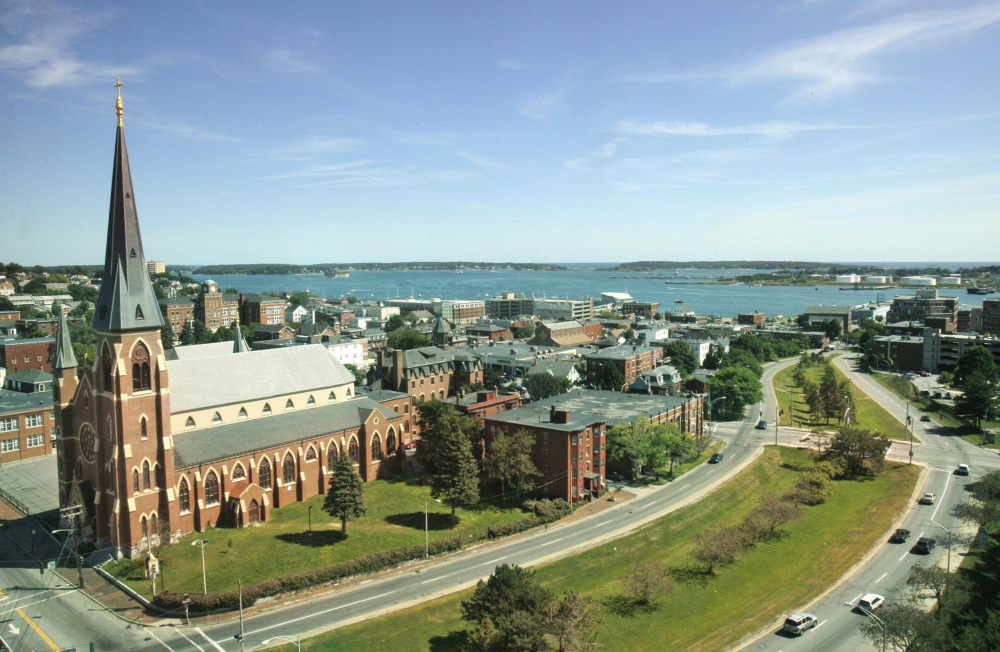The city committee studying how to reconfigure Franklin Street is recommending that a “pedestrian friendly” roundabout be installed at the intersection of Franklin and Commercial streets near the entrance to the Casco Bay Lines ferry terminal.
Members of the Public Advisory Committee that has spent months studying ways to make the Portland arterial safer for pedestrians, bicyclists and motorists believes that a slightly raised roundabout at that end of Franklin Street would slow vehicle and pedestrian traffic that at times can be chaotic, with people disembarking from cruise ships, Old Port visitors crossing the wide street on foot, and motorists entering and exiting the ferry terminal.
The roundabout would include a clearly marked pedestrian crossing and might be distinguished by the presence of a monument or water fountain.
“Our concern is that a significant amount of traffic and people on foot are using that intersection,” said Carol Morris, spokeswoman for the committee. “Right now, the street is extremely wide. We need to make it safer for walkers and make it more appealing as the gateway, especially for cruise ship passengers, to the city.”
After working for nearly two years on Phase 2 of the Franklin Street study, the Public Advisory Committee will finalize its recommendations at a City Hall meeting Wednesday at 6 p.m.
The Franklin Street arterial was built as part of the urban renewal movement in the late 1960s. Entire neighborhoods, mostly of immigrant families, were uprooted and the entire India Street neighborhood was severed from Portland’s downtown to create a major thoroughfare to move traffic into and out of the city. Franklin Street now serves as a heavily traveled corridor that moves traffic off Interstate 295 and into Portland. More than 20,000 vehicles a day use the street.
After the committee finalizes its recommendations Wednesday, Morris said it will present its report to members of the City Council’s Transportation, Sustainability and Energy Committee – probably in late April. That panel will review the plan before making a recommendation to the full City Council, which will have final say over what, if any, changes are implemented.
“Overall, I’m enthusiastic about the plan, but I suspect there will be concerns around the buildout, which could last beyond my lifetime,” said Steve Hirshon, president of the Bayside Neighborhood Association. “But it provides an opportunity to do some positive things along what has been for the most part a neglected corridor. There is a lot of room for improvement.”
Though it’s too soon to say how much the changes would cost, funding would come from municipal, state and federal sources.
“I think that the vast majority of people I’ve talked to agree that at least something needs to be done to Franklin Street,” said Markos Miller, co-chairman of the Public Advisory Committee. “There is general consensus that there are problems with Franklin Street that need to be fixed. We’ve got an opportunity here to update that road to the 21st century and to reknit the fabric of that neighborhood that was lost when it was built.”
In addition to the roundabout, the committee is recommending that Lincoln Park get bigger, that 5-foot bicycle lanes be added to both sides of the street, that the 100-foot-wide medians stretching almost the entire length of Franklin Street be reduced to between 5 and 10 feet, that some traffic movements at Marginal Way and Franklin streets be eliminated, and that the severed ends of Oxford and Federal streets be reconnected.
When Franklin Street was built decades ago, those streets were chopped up. Under the plan, the section of Federal Street that runs in front of the county and federal courthouses would extend across Franklin Street and connect with the other half of Federal Street located on Munjoy Hill.
The committee also is recommending that Oxford Street be reconnected by a pedestrian crossing. Currently, it is not uncommon to see pedestrians in the area running across Franklin Street and seeking refuge in the median before continuing across.
Morris said another issue identified by the committee was the public’s desire to make Lincoln Park a destination. When Franklin Street was built in the 1960s, the city lost about one-third of Lincoln Park. The redesign would allow the 2.5-acre park to grow slightly.
Another change, which is aimed at improving traffic flow through the intersection of Marginal Way and Franklin Street, would prohibit vehicles traveling southwest on Marginal Way from going straight or making left-hand turns onto Franklin Street. Vehicles coming from that direction would only be permitted to turn right onto the Interstate 295 ramp.
“By eliminating that movement we are gaining a turn of the traffic signal,” Morris explained. “It was pretty widely understood that no one likes that intersection.”
Copy the Story Link
Send questions/comments to the editors.




Success. Please wait for the page to reload. If the page does not reload within 5 seconds, please refresh the page.
Enter your email and password to access comments.
Hi, to comment on stories you must . This profile is in addition to your subscription and website login.
Already have a commenting profile? .
Invalid username/password.
Please check your email to confirm and complete your registration.
Only subscribers are eligible to post comments. Please subscribe or login first for digital access. Here’s why.
Use the form below to reset your password. When you've submitted your account email, we will send an email with a reset code.